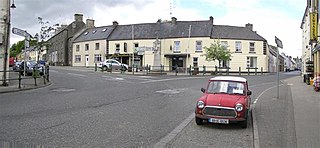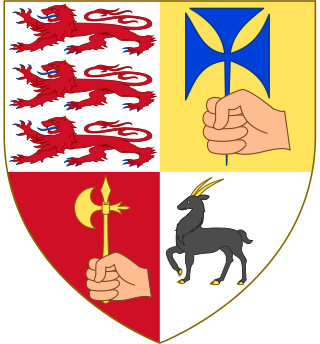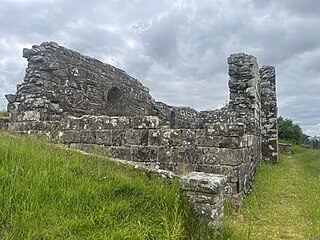Related Research Articles
In Eastern Christianity, an iconostasis is a wall of icons and religious paintings, separating the nave from the sanctuary in a church. Iconostasis also refers to a portable icon stand that can be placed anywhere within a church. The iconostasis evolved from the Byzantine templon, a process complete by the 15th century.
The vast majority of placenamesin Ireland are anglicisations of Irish language names; that is, adaptations of the Irish names to English phonology and spelling. However, some names come directly from the English language, and a handful come from Old Norse and Scots. The study of placenames in Ireland unveils features of the country's history and geography and the development of the Irish language. The name of Ireland itself comes from the Irish name Éire, added to the Germanic word land. In mythology, Éire was an Irish goddess of the land and of sovereignty.
A townland is a small geographical division of land, historically and currently used in Ireland and in the Western Isles in Scotland, typically covering 100–500 acres (40–202 ha). The townland system is of Gaelic origin, antedating the Norman invasion, and most have names of Irish origin. However, some townland names and boundaries come from Norman manors, plantation divisions, or later creations of the Ordnance Survey. The total number of inhabited townlands in Ireland was 60,679 in 1911. The total number recognised by the Irish Place Names database as of 2014 was 61,098, including uninhabited townlands, mainly small islands.

Inis Cathaigh or Scattery Island is an island in the Shannon Estuary, Ireland, off the coast of Kilrush, County Clare. The island is home to a lighthouse, a ruined monastery associated with Saints Senan and Canir, an Irish round tower and the remains of an artillery battery. The last residents left in 1969. Most of the island is now owned by the Office of Public Works, who run a small visitor centre and carry out repairs and maintenance on the island; it was bought by Dúchas in 1991.The Irish name Inis Cathaigh was formerly anglicised Iniscathy, which later became Iniscattery and finally Scattery.

Carrickmore is a small town in County Tyrone, Northern Ireland. It is situated in the historic barony of Omagh East, the civil parish of Termonmaguirk and the Roman Catholic Parish of Termonmaguirc between Cookstown, Dungannon and Omagh. It had a population of 612 in the 2001 Census. In the 2011 Census 2,330 people lived in the Termon Ward, which covers the Carrickmore and Creggan areas.
A coarb, from the Old Irish comarbae, meaning "heir" or "successor", was a distinctive office of the medieval church among the Gaels of Ireland and Scotland. In this period coarb appears interchangeable with "erenach", denoting the episcopally nominated lay guardian of a parish church and headman of the family in hereditary occupation of church lands. The coarb, however, often had charge of a church which had held comparatively high rank in pre‐Norman Ireland, or one still possessed of relatively extensive termon lands.
The medieval Irish office of erenagh was responsible for receiving parish revenue from tithes and rents, building and maintaining church property and overseeing the termonn lands that generated parish income. Thus he had a prebendary role. The erenagh originally had a tonsure but took no other holy orders; he had a voice in the Chapter when they consulted about revenues, paid a yearly rent to the Bishop and a fine on the marriage of each daughter. The role usually passed down from generation to generation in certain families in each parish. After the Reformation and the Dissolution of the Monasteries the role of erenagh became subsumed in the responsibilities of the parson in each parish.

Pettigo, also spelt Pettigoe, is a small village and townland on the border of County Donegal, Republic of Ireland, and County Fermanagh, Northern Ireland. It is bisected by the Termon River which is part of the border between the Republic of Ireland and Northern Ireland.
Falvey is a surname which is an anglicisation of the name Ó Fáilbhe: in the Irish language Ó means "descendant" [of] and "fáilbhe" literally means "lively, pleasant, sprightly, merry, cheerful" or, according to another historian, "joker". Other anglicisations include O’Falvie, O’Falvy, O’Failie, O’Falvey, Falvey, Fealy and Fealey. The O’Falvey's trace their descent to Conaire, who was King of Ireland at the beginning of the Christian era. The O’Falvey's are recorded to have been powerful chiefs of Corcu Duibne, specifically the Dingle Peninsula of modern-era County Kerry, the barony of Corcaguiny. They were also Lords of Inveragh during the tenth century, and the hereditary admirals of Desmond. The veracity of such claims is in their intent more than their detail, thus an "admiral" may well have been the leader of some boats, and a "lord" may have been a somewhat less imposing figure than a Victorian English nobleman.

Corcomroe Abbey is an early 13th-century Cistercian monastery located in the north of the Burren region of County Clare, Ireland, a few miles east of the village of Ballyvaughan in the Barony of Burren. It was once known as "St. Mary of the Fertile Rock", a reference to the Burren's fertile soil.

Termon is a village in the north of County Donegal, Ireland.

The McGrath family is an Irish clan. The name is derived from the Gaelic Mac Craith, recorded in other written texts as Mag Craith, Mag Raith and Macraith, including the Annals of the Four Masters and the Annals of Ulster. McGrath is a surname of ancient Irish origin, and is borne by the descendants of a number of septs, each with a common origin in the Kingdom of Thomond, a kingdom that existed before the Norman invasion and was located in north Munster.
Saint Brecan was an Irish saint active in the 5th century AD. There are legends concerning Brecan from Clare and Aran, and wells and churches are dedicated to him in various places in Ireland. His main monument is the Tempull Breccain complex on Inishmore in the Aran Islands.

Cloneary is a townland in the civil parish of Templeport, County Cavan, Ireland. It lies in the Roman Catholic parish of Templeport and barony of Tullyhaw.

Port is a townland in the civil parish of Templeport, County Cavan, Ireland. It lies in the Roman Catholic parish of Templeport and barony of Tullyhaw.
Termon is a village in the north of County Donegal, Ireland.

The Inneenboy cross or the Roughan Hill Tau Cross is a stone tau cross located in County Clare, Ireland. It is a National Monument.

Kildallan is a townland in the civil parish of Kildallan, barony of Tullyhunco, County Cavan, Ireland.

Killaghaduff is a townland in the civil parish of Kinawley, barony of Tullyhaw, County Cavan, Ireland.

Banagher Old Church is a monument in state care and a scheduled monument in Banagher near Dungiven in County Londonderry, Northern Ireland. Local tradition ascribes the foundation of the church to either Saint Patrick, or more commonly, St Muiredach O’Heney. Whilst an inscription etched in the 1730s states that ‘this church was built in ye year of God 474’, there is no evidence that the church is that old. Instead it was likely founded towards the end of the 11th century. Its first definitive mention in recorded history is 1121, when it is mentioned in the Annals of Ulster as the site where the king of Ciannachta, was killed by his own kinsmen. It was later noted as the base for Archbishop Colton of Armagh's 1397 visit to the Diocese of Derry. It is unknown when the church was abandoned, but a survey of churches of the area in 1622 noted it was already ruined.